The Trumpeter Swan (Cygnus buccinator) is the largest native waterfowl in North America and is famous for its loud, trumpet-like call. These majestic birds use a variety of vocalizations to communicate with each other, from soft grunts to powerful honks. In this topic, we will explore what a Trumpeter Swan sounds like, why they make these calls, and how their vocalizations compare to other swans.
1. The Signature Sound of a Trumpeter Swan
The Trumpeter Swan gets its name from its distinctive, trumpet-like call. This sound is deep, resonant, and carries over long distances. It often resembles a French horn or a low-pitched bugle.
1.1. Description of the Call
- The call is loud and clear, often lasting for several seconds.
- It has a rich, deep tone that can be heard from far away.
- Swans often repeat the call in a series of honks, creating a rhythmic pattern.
1.2. What Does It Sound Like?
- Many birdwatchers describe it as “low, musical honking.”
- It is deeper and more powerful than the calls of other swans.
- Some people say it sounds like a bugle or a brass instrument.
2. Why Do Trumpeter Swans Make Noise?
Trumpeter Swans are highly vocal birds that use their calls for different purposes.
2.1. Communication Between Mates
Swans form strong pair bonds and use calls to stay connected.
- They call out to each other when flying or swimming.
- During courtship, they engage in duet calling, where both swans vocalize together.
- This strengthens their bond and helps them recognize each other.
2.2. Warning and Defense Calls
Swans are protective of their territory and young.
- If they sense danger, they give a loud, aggressive honk to warn others.
- When threatened, they may also hiss or flap their wings.
- Their deep calls can alert other swans to potential predators.
2.3. Calls Between Parents and Cygnets
Young swans, called cygnets, communicate with their parents through soft sounds.
- Cygnets make high-pitched whistles and peeps to get attention.
- Parents respond with softer, reassuring grunts to comfort their young.
- This helps cygnets stay close to their parents in the water.
3. How Do Trumpeter Swans Compare to Other Swans?
Trumpeter Swans are often confused with other swan species, but their calls set them apart.
3.1. Trumpeter Swan vs. Tundra Swan
- Trumpeter Swan: Deep, resonant, and loud trumpeting.
- Tundra Swan: Softer, more nasal call, often compared to a “whooping” sound.
3.2. Trumpeter Swan vs. Mute Swan
- Trumpeter Swan: Uses vocal calls frequently.
- Mute Swan: Mostly silent, but can hiss when threatened.
4. How Far Can You Hear a Trumpeter Swan?
Because of their size and powerful lungs, Trumpeter Swans can be heard from over a mile away.
- Their call is most noticeable in open wetlands and lakes.
- During migration, flocks of swans call to each other while flying, creating a chorus of deep trumpeting sounds in the sky.
5. Can Trumpeter Swans Imitate Sounds?
Unlike some birds, Trumpeter Swans do not mimic other sounds. However, their vocal range allows them to create different tones and patterns. Some swans may develop unique calls that help identify them within a flock.
6. The Role of Vocalizations in Swan Behavior
6.1. Social Interactions
Swans use vocalizations to express emotions and intentions.
- Friendly calls indicate recognition and bonding.
- Aggressive calls signal dominance and territorial defense.
6.2. Seasonal Changes in Calls
- During breeding season, swans call more frequently to their mates.
- In winter, flocks communicate while migrating, ensuring they stay together.
7. Conclusion
The Trumpeter Swan is one of the most vocal and impressive waterfowl species. Its deep, powerful call is a key part of its identity, helping it communicate with mates, warn of danger, and stay connected with its young. Whether echoing across wetlands or filling the sky during migration, the sound of a Trumpeter Swan is truly unforgettable.
